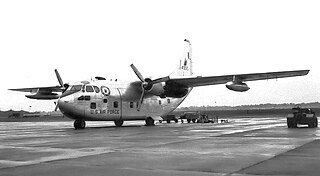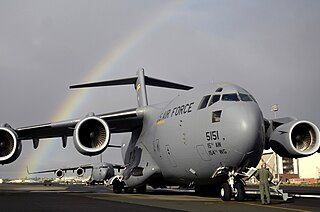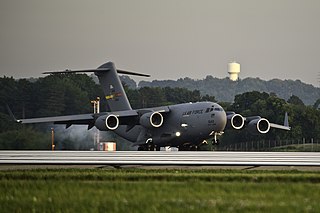
Donaldson Air Force Base is a former facility of the United States Air Force located south of Greenville, South Carolina. It was founded in 1942 as Greenville Army Air Base; it was deactivated in 1963 and converted into a civilian airport. It is currently an active airfield known as Donaldson Center Airport.

The 309th Maintenance Wing is an inactive wing of the United States Air Force last based at Hill Air Force Base, Utah. On July 12, 2012 it was inactivated and its function became part of the Ogden Air Logistics Complex.

The 728th Airlift Squadron is a United States Air Force Reserve squadron, assigned to the 446th Operations Group, stationed at McChord Field, Joint Base Lewis-McChord, Washington. It is an associate unit of the active duty 8th Airlift Squadron of the 62d Airlift Wing.

The 483rd Tactical Airlift Wing was a tactical airlift and composite wing assigned to Pacific Air Forces during the Vietnam War. It was the host organization at Cam Ranh Bay Air Base South Vietnam from 1970 to 1972.

The 56th Air Refueling Squadron is an active unit of the United States Air Force. It is part of the 97th Operations Group at Altus Air Force Base, Oklahoma. It operates Boeing KC-46 Pegasus aircraft, conducting initial and advanced aircrew training for air refueling operations.

The 535th Airlift Squadron is part of the 15th Wing at Joint Base Pearl Harbor–Hickam, Hawaii. It operates C-17 Globemaster III aircraft providing airlift in the Pacific theater.

The 311th Airlift Squadron is part of the 375th Airlift Wing at Peterson Air Force Base, Colorado. It operated Learjet C-21 aircraft providing executive airlift for Combatant Commanders.

The 357th Airlift Squadron is a Tactical Airlift unit of the United States Air Force assigned to the Air Force Reserve Command and part of the 908th Airlift Wing at Maxwell Air Force Base, Alabama. It operates Lockheed C-130H Hercules aircraft providing global airlift. The 357th AS operates (8) C-130H2 aircraft that were built in the 1990s, which utilize Flight Engineers and Navigators, along with the crew complement of Pilots and Loadmasters.

The 457th Airlift Squadron was an executive airlift unit stationed at Andrews Air Force Base, Maryland. It, and its predecessor, the 1402nd Military Airlift Squadron, operated a number of executive aircraft starting in 1975. From the mid-1990s, the squadron operated only Learjet C-21 aircraft.

The 459th Airlift Squadron is an active United States Air Force unit assigned to the 374th Airlift Wing at Yokota Air Base, Japan. It has been stationed at Yokota since 1993. It has performed its current mission since activating in 1975 as the 1400th Military Airlift Squadron. The 1400th Squadron was consolidated with the 459th in 1991.

The 700th Airlift Squadron is part of the 94th Airlift Wing at Dobbins Air Reserve Base, Georgia. It operates Lockheed C-130 Hercules aircraft providing global airlift.

The 729th Airlift Squadron is a United States Air Force Reserve squadron, assigned to the 452d Operations Group, stationed at March Air Reserve Base, California. It operates Boeing C-17 Globemaster III aircraft providing global airlift any time, any place.

The 336th Air Refueling Squadron is a United States Air Force Reserve squadron, assigned to the 452d Operations Group, stationed at March Joint Air Reserve Base, California. The squadron shares its aircraft and facility with the 912th Air Refueling Squadron, a USAF Associate Unit assigned to the 92d Air Refueling Wing.

The 94th Operations Group is the flying component of the 94th Airlift Wing, assigned to the United States Air Force Reserve. The group is stationed at Dobbins Air Reserve Base, Georgia.

The 332d Airlift Flight is an inactive United States Air Force unit. it was first organized in India in 1944 as the 11th Combat Cargo Squadron. As the 332d Troop Carrier Squadron it remained in China through 1947. The squadron was activated again for the Berlin Airlift from 1948 to 1949.

The 464th Troop Carrier Group was a theater airlift unit of the United States Air Force during the Cold War. It served in the United States under Tactical Air Command between 1953 and 1957. The group operated Fairchild C-119 Flying Boxcar and Fairchild C-123 Provider aircraft as the flying element of the 464th Troop Carrier Wing until being inactivated when the wing was reorganized.

The 362d Tactical Electronic Warfare Squadron is an inactive United States Air Force unit. It was last assigned to the 6498th Air Base Wing at Da Nang Air Base, Republic of Vietnam, where it was inactivated on 28 February 1973.

The 537th Airlift Squadron is an inactive squadron of the United States Air Force. The unit was last active at Joint Base Elmendorf-Richardson Alaska, where it was inactivated on 13 September 2013.

The 536th Tactical Airlift Squadron is an inactive squadron of the United States Air Force. The unit was last active at Cam Ranh Bay Air Base Viet Nam, where it was inactivated on 15 October 1971.

The 330th Aircraft Sustainment Group was a group of the United States Air Force stationed at Robins Air Force Base, Georgia. It was last active in June 2010

































